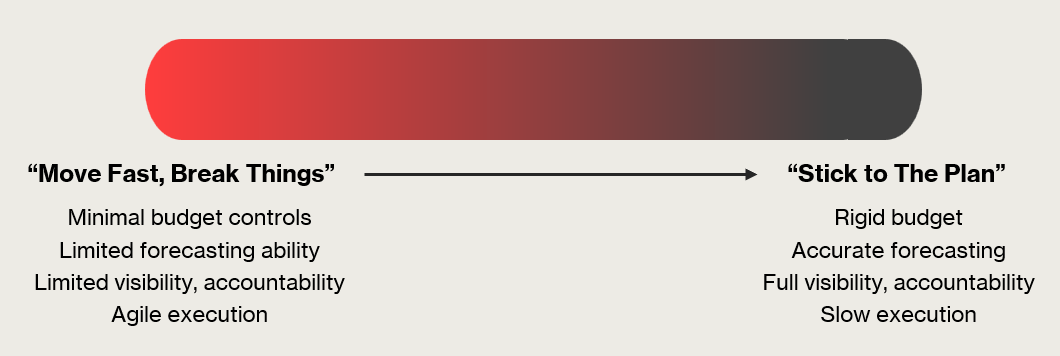Companies tend to evolve from a state of financial chaos to control. An important question is: What’s the sweet spot for your company today?
In the early days, companies’ plans are fluid; they move fast, break things, and let teams spend with limited oversight. It’s messy, but it allows companies to react quickly while tuning product-market fit and building operational infrastructure. Later on, companies begin to adopt budgets, scrutinize expenses, establish guardrails and accountability.
The Tradeoffs of Financial Control: Speed vs. Stability
In finance, “control” typically refers to the systems, processes, and approvals that govern how money moves through a company. For CFOs and finance leaders, this includes things like:
- Who can approve spending—and for how much
- How budgets are created, tracked, and enforced
- How real-time visibility into spend is managed
- Whether teams can make autonomous purchasing decisions
- The rigor of expense policies and compliance frameworks
At one end of the spectrum—low control—the goal is speed, agility, and trust in team judgment. Early-stage startups often live here. Decisions are made on the fly. Engineers and marketers can buy tools and run experiments without waiting for approvals. Finance’s role is often reactive, closing books and chasing down receipts after the fact. The upside is momentum. The downside is waste, duplication, and a lack of financial visibility.
At the other end—high control—the aim is predictability, accountability, and governance. Mid-to-late stage companies may centralize spending decisions, require multi-level approvals, use procurement systems, and integrate finance deeply into planning. This can reduce unnecessary spend, improve compliance, and provide the board with confidence. But it can also slow teams down, create bottlenecks, and breed frustration—especially in high-velocity functions like product, growth, and sales.
This isn’t just a binary choice. Most companies move along a spectrum, with different functions requiring different levels of oversight. For example, marketing spend may need more flexibility, while infrastructure or headcount changes warrant tighter scrutiny.
The real tradeoff isn’t control vs. no control—it’s centralization vs. empowerment, and precision vs. speed. The best finance leaders recognize that control is a means to an end—not the end itself. Their goal isn’t to say “no”—it’s to build systems that help teams make faster, smarter decisions without losing track of the financial picture.
Striking the Right Balance: Practical Recommendations
Finding your company’s sweet spot requires more than theory. Here are a few practical ways to evolve financial control without stifling momentum:
1. Control the Big Buckets First
Focus on the largest and fastest-growing spend categories, such as sales and marketing. These areas often account for a significant share of total expenses, making them the highest-leverage areas to introduce guardrails.
2. Use Technology to Scale Oversight
Modern spend platforms like Ramp and Brex allow finance teams to parameterize policies within the tools themselves. This means you can automate card limits, merchant restrictions, approval thresholds, and more—turning manual policing into proactive governance.
3. Catch Spend Earlier in the Lifecycle
Waiting until an invoice hits your inbox is too late. Implement approvals at the contract review stage or even earlier through a new spend or new vendor intake process. This shifts finance from being a backstop to being a strategic partner in spend decisions.
4. Match Controls to Team Dynamics
Different functions need different freedoms. Enable product and marketing to move fast within predefined budgets while applying more rigor to hiring plans, infrastructure costs, or large vendor contracts.
5. Build Transparency, Not Bureaucracy
Make spend data visible to team leaders and execs. Often, just seeing where money is going can drive better decisions without adding extra layers of friction.
It’s not about jumping from one extreme to the other. It’s about evolving thoughtfully and deliberately.
- Too much control too early can strangle innovation and piss off your most productive, creative employees.
- Too little control too late can spell disaster.
- The art lies in finding that perfect balance – where structure meets flexibility, and control enables rather than inhibits growth.
- To figure out your sweet spot, you need to look at your company, its size, its board, its executive team and its culture.
About the Author:
Karsten Loose is co-founder and Managing Partner at Karlon Group, a fractional finance and accounting firm that helps companies build, scale, and optimize their finance and accounting functions. Karlon Group works with companies across SaaS, consumer, manufacturing and technology, offering a full suite of finance and accounting support tailored to each client’s changing needs.
